Almond Fruit Drop Patterns under Mediterranean Conditions
Abstract
1. Introduction
2. Materials and Methods
2.1. Orchards and Experimental Design
2.2. Horticultural Assessments & Data Analysis
3. Results
3.1. General Fruit Drop Patterns
3.2. Fruit Drop Patterns by Cultivar
3.3. Fruit Drop Patterns by Rootstock
3.4. Fruit Drop Patterns by Pruning Type
3.5. Fruit Drop Patterns and Yield
4. Discussion
5. Conclusions
Author Contributions
Funding
Data Availability Statement
Acknowledgments
Conflicts of Interest
References
- Gradziel, T.M.; Curtis, R.; Socias i Company, R. Almonds: Botany, Production and Uses. In Almonds: Botany, Production and Uses; CABI: Boston, MA, USA, 2017; pp. 70–86. [Google Scholar]
- Batlle, I.; Dicenta, F.; Socias i Company, R.; Gradziel, T.M.; Wirthensohn, M.; Duval, H.; Vargas, F.J. Classical genetics and breeding. In Almonds: Botany, Production and Uses; Rafel Socias i Company, Gradziel, T.M., Eds.; CABI: Boston, MA, USA, 2017; pp. 111–148. [Google Scholar]
- Socias i Company, R.; Gomez Aparisi, J.; Alonso, J.; Rubio-Cabetas, M.; Kodad, O. Retos y perspectivas de los nuevos cultivares y patrones de almendro para un cultivo sostenible. Inf. Técnica Econó. Agrar. 2009, 105, 99–116. [Google Scholar]
- Almond Board of Australia. Almond Insights 2019–2020; Australian Almonds: Loxton, Australia, 2020. [Google Scholar]
- Almond Board of California. Almond Almanac 2019; California Almonds: Modesto, CA, USA, 2020. [Google Scholar]
- MAPAMA. Anuario de Estadística Agraria 2019; Ministerio de Pesca, Agricultura y Alimentación, Gobierno de España: Madrid, Spain, 2020. [Google Scholar]
- Miarnau, X.; Torguet, L.; Zazurca, L.; Maldonado, L.; Girabet, R.; Batlle, I.; Rovira, M. El futuro del almendro en España: ¿Será posible producir 4.000 kg de grano/ha? Horticultura 2018, 337, 16–26. [Google Scholar]
- Tombesi, S.; Lampinen, B.D.; Metcalf, S.; DeJong, T.M. Yield in almond is related more to the abundance of flowers than the relative number of flowers that set fruit. Calif. Agric. 2017, 71, 68–74. [Google Scholar] [CrossRef]
- Kodad, O.; Socias i Company, R. Flower age and pollenizer could affect fruit set in late-blooming self-compatible almond cultivars under warm climatic conditions. Sci. Hortic. 2013, 164, 359–365. [Google Scholar] [CrossRef]
- Maita, S.; Sotomayor, C. The effect of three plant bioregulators on pollen germination, pollen tube growth and fruit set in almond [Prunus dulcis (Mill.) DA Webb] cvs. Non Pareil and Carmel. Electron. J. Biotechnol. 2015, 18, 381–386. [Google Scholar] [CrossRef]
- Sorkheh, K.; Shiran, B.; Rouhi, V.; Khodambashi, M.; Wolukau, J.; Ercisli, S. Response of in vitro pollen germination and pollen tube growth of almond (Prunus dulcis Mill.) to temperature, polyamines and polyamine synthesis inhibitor. Biochem. Syst. Ecol. 2011, 39, 749–757. [Google Scholar] [CrossRef]
- Tombesi, S.; Lampinen, B.D.; Metcalf, S.; DeJong, T.M. Spur fruit set is negatively related with current-year spur leaf area in almond. HortScience 2015, 50, 322–325. [Google Scholar] [CrossRef]
- The Almond Doctor. Available online: https://thealmonddoctor.com/2016/03/07/almond-set-and-nut-drop/ (accessed on 12 February 2021).
- Kester, D.E.; Griggs, W. Fruit setting in the almond: The pattern of flower and fruit drop. Proc. Am. Soc. Hort. Sci. 1959, 74, 214–219. [Google Scholar]
- Vargas, F.J.; Romero, M.; Clavé, J.; Vergés, J.; Santos, J.; Batlle, I. ‘Vairo’, ‘Marinada’, ‘Constantí’, and ‘Tarraco’ almonds. HortScience 2008, 43, 535–537. [Google Scholar] [CrossRef]
- Vargas, F.J.; Romero, M.A. Masbovera, Glorieta, and Francolí, three new almond varieties from IRTA. Acta Hortic. 1994, 373, 75–82. [Google Scholar] [CrossRef]
- Dicenta, F.; Sánchez-Pérez, R.; Rubio, M.; Egea, J.; Batlle, I.; Miarnau, X.; Palasciano, M.; Lipari, E.; Confolent, C.; Martínez-Gómez, P. The origin of the self-compatible almond ‘Guara’. Sci. Hortic. 2015, 197, 1–4. [Google Scholar] [CrossRef]
- Felipe, A.J.; Socias i Company, R. ‘Ayles’, ‘Guara’, and ‘Moncayo’ almonds. HortScience 1987, 22, 961–962. [Google Scholar]
- Socias i Company, R.; Felipe, A. ‘Belona’ and ‘Soleta’ almonds. HortScience 2007, 42, 704–706. [Google Scholar] [CrossRef]
- Dicenta, F.; Cremades, T.; Martínez-García, P.J.; Martínez-Gómez, P.; Ortega, E.; Rubio, M.; Sánchez-Pérez, R.; López-Alcolea, J.; Egea, J. Penta and Makako: Two extra-late flowering self-compatible almond cultivars from CEBAS-CSIC. HortScience 2018, 53, 1700–1702. [Google Scholar] [CrossRef]
- Egea, J.; Dicenta, F.; Berenguer, T.; García, J. ‘Antoñeta’ and ‘Marta’ almonds. HortScience 2000, 35, 1358–1359. [Google Scholar] [CrossRef]
- Grasselly, C. Avijor ‘Lauranne’. L’Arboriculture Fruit. 1991, 436, 75. [Google Scholar]
- Grasselly, C.; Duval, H. L’amandier; CTIFL: Paris, France, 1997. [Google Scholar]
- Felipe, A. El Almendro. I El Material Vegetal; Integrum: Lleida, Spain, 2000. [Google Scholar]
- Bernhard, R.; Grasselly, C. Les pêchers x amandiers. Arboric. Fruit 1981, 328, 37–42. [Google Scholar]
- Vargas, F.J.; Romero, M.A.; Clavé, J.; Batlle, I.; Miarnau, X.; Alegre, S. Important traits in IRTA’s new almond cultivars. Acta Hortic. 2011, 912, 359–365. [Google Scholar] [CrossRef]
- Lordan, J.; Zazurca, L.; Maldonado, M.; Torguet, L.; Alegre, S.; Miarnau, X. Horticultural Performance of ‘Marinada’ and ‘Vairo’ Almond Cultivars Grown on a Genetically Diverse Set of Rootstocks. Sci. Hortic. 2019, 256, 1–12. [Google Scholar] [CrossRef]
- Felipe, A.; Gomez-Aparisi, J.; Vargas, F.; Romero, M.; Monastra, F.; Caboni, E.; Simeone, A.; Isaakidis, A. Obtention et selection de porte-greffe pour l’amandier multiplies par voie vegetative. Opt. Mediterr. N 1997, 16, 73. [Google Scholar]
- Xarxa Agrometeorològica de Catalunya (XAC) and Servei Meteorològic de Catalunya. Available online: https://www.ruralcat.net/web/guest/agrometeo.estacions (accessed on 20 April 2021).
- Allen, R.G.; Pereira, L.S.; Raes, D.; Smith, M. FAO Irrigation and drainage paper No. 56. Rome Food Agric. Organ. U. N. 1998, 56, e156. [Google Scholar]
- Felipe, A. Estados fenológicos del almendro. Inf. Tec. Econ. Agrar. 1977, 8, 8–9. [Google Scholar]
- Brown, D. Climate in relation to decidious fruit production in California. IV. Effect of the mild winter of 1950–1951 on decidious fruits in northern California. Proc. Am. Soc. Hortic. Sci. 1952, 59, 111–118. [Google Scholar]
- Lordan, J.; Reginato, G.; Lakso, A.; Francescatto, P.; Robinson, T. Natural fruitlet abscission as related to apple tree carbon balance estimated with the MaluSim model. Sci. Hortic. 2019, 247, 296–309. [Google Scholar] [CrossRef]
- Jackson, J.; Hamer, P. The causes of year-to-year variation in the average yield of Cox’s Orange Pippin apple in England. J. Hortic. Sci. 1980, 55, 149–156. [Google Scholar] [CrossRef]
- Jackson, J.; Hamer, P.; Wickenden, M. Effects of early spring temperatures on the set of fruits of Cox’s Orange Pippin apple and year-to-year variation in its yields. Acta Hortic. 1983, 139, 75–82. [Google Scholar] [CrossRef]
- Lakso, A. Importance of climate and microclimate to yield and quality in horticultural crops. In Proceedings of the Agrometeorology: 2nd International Cesena Agricultura Conference, Cesena, Italy, 8–9 October 1987. [Google Scholar]
- Luckwill, L. Studies of fruit development in relation to plant hormones: I. Hormone production by the developing apple seed in relation to fruit drop. J. Hortic. Sci. 1953, 28, 14–24. [Google Scholar] [CrossRef]
- Koukourikou-Petridou, M.A. The relation between the levels of extractable and diffusible IAA in almond fruits and their “June drop”. Plant Growth Regul. 2003, 39, 107–112. [Google Scholar] [CrossRef]
- Lordan, J.; Reginato, G.H.; Lakso, A.N.; Francescatto, P.; Robinson, T.L. Modelling physiological and environmental factors regulating relative fruit set and final fruit numbers in apple trees. J. Hortic. Sci. Biotechnol. 2020, 95, 600–616. [Google Scholar] [CrossRef]
- Valdebenito, D.; Tombesi, S.; Tixier, A.; Lampinen, B.; Brown, P.; Saa, S. Spur behavior in Almond trees (Prunus dulcis [Mill.] DAWebb): Effects of flowers, fruit, and “June drop” on leaf area, leaf nitrogen, spur survival and return bloom. Sci. Hortic. 2017, 215, 15–19. [Google Scholar] [CrossRef]
- Racskó, J.; Leite, G.; Petri, J.; Zhongfu, S.; Wang, Y.; Szabó, Z.; Soltész, M.; Nyéki, J. Fruit drop: The role of inner agents and environmental factors in the drop of flowers and fruits. Int. J. Hortic. Sci. 2007, 13, 13–23. [Google Scholar] [CrossRef]
- Felipe, A. Rootstocks for almond. Present situation. In Options Mediterraneennes. Serie A. Séminaires Méditerranéens; CIHEAM: Zaragoza, Spain, 1989; Volume 5, pp. 13–18. [Google Scholar]
- Yahmed, J.B.; Ghrab, M.; Mimoun, M.B. Eco-physiological evaluation of different scion-rootstock combinations of almond grown in Mediterranean conditions. Fruits 2016, 71, 185–193. [Google Scholar] [CrossRef]
- Lordan, J.; Fazio, G.; Francescatto, P.; Robinson, T.L. Effects of apple (Malus × domestica) rootstocks on scion performance and hormone concentration. Sci. Hortic. 2017, 225, 96–105. [Google Scholar] [CrossRef]
- Sorce, C.; Massai, R.; Picciarelli, P.; Lorenzi, R. Hormonal relationships in xylem sap of grafted and ungrafted Prunus rootstocks. Sci. Hortic. 2002, 93, 333–342. [Google Scholar] [CrossRef]
- Tworkoski, T.; Miller, S. Endogenous hormone concentrations and bud-break response to exogenous benzyl adenine in shoots of apple trees with two growth habits grown on three rootstocks. J. Horticult. Sci. Biotechnol. 2007, 82, 960–966. [Google Scholar] [CrossRef]
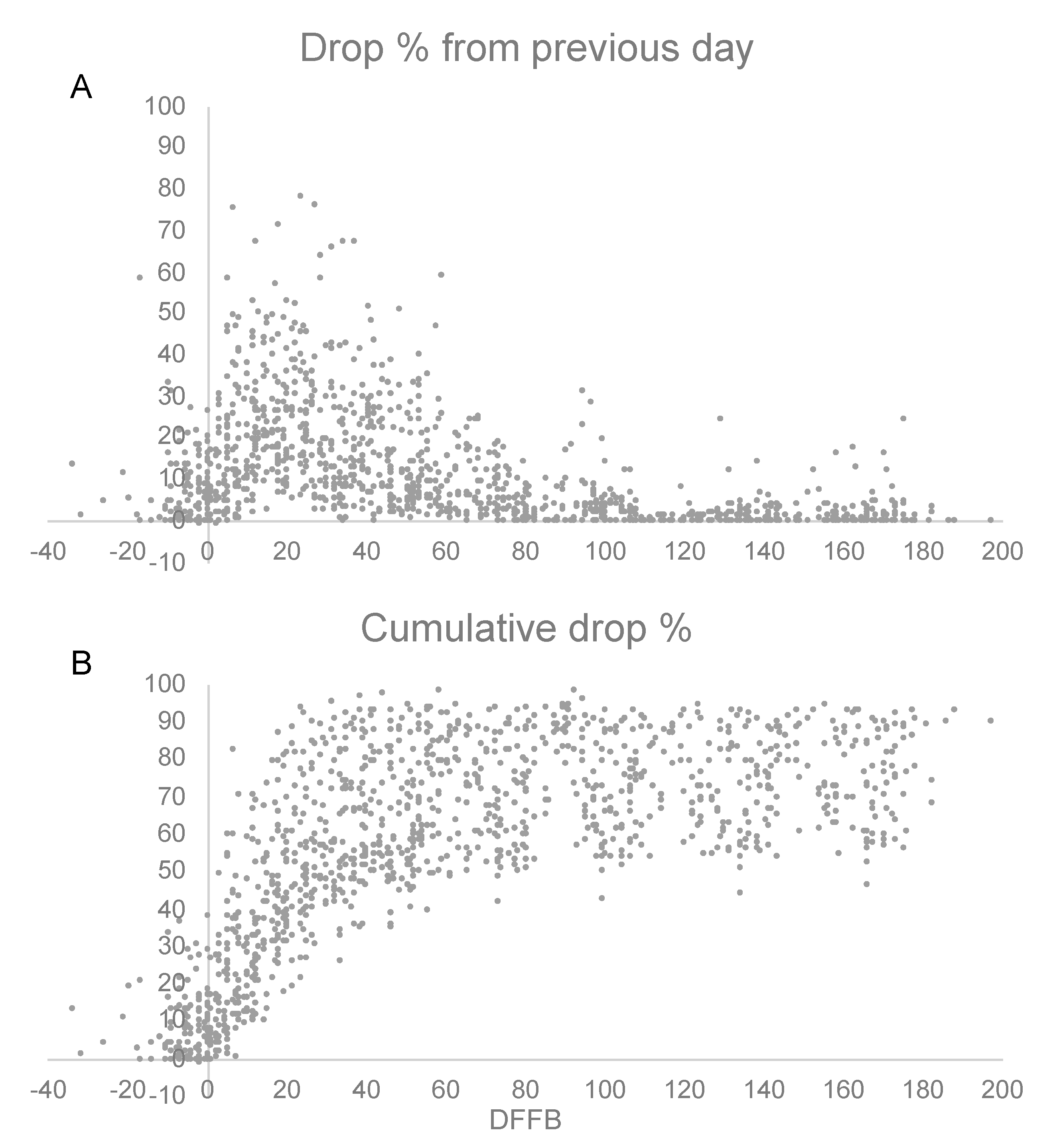
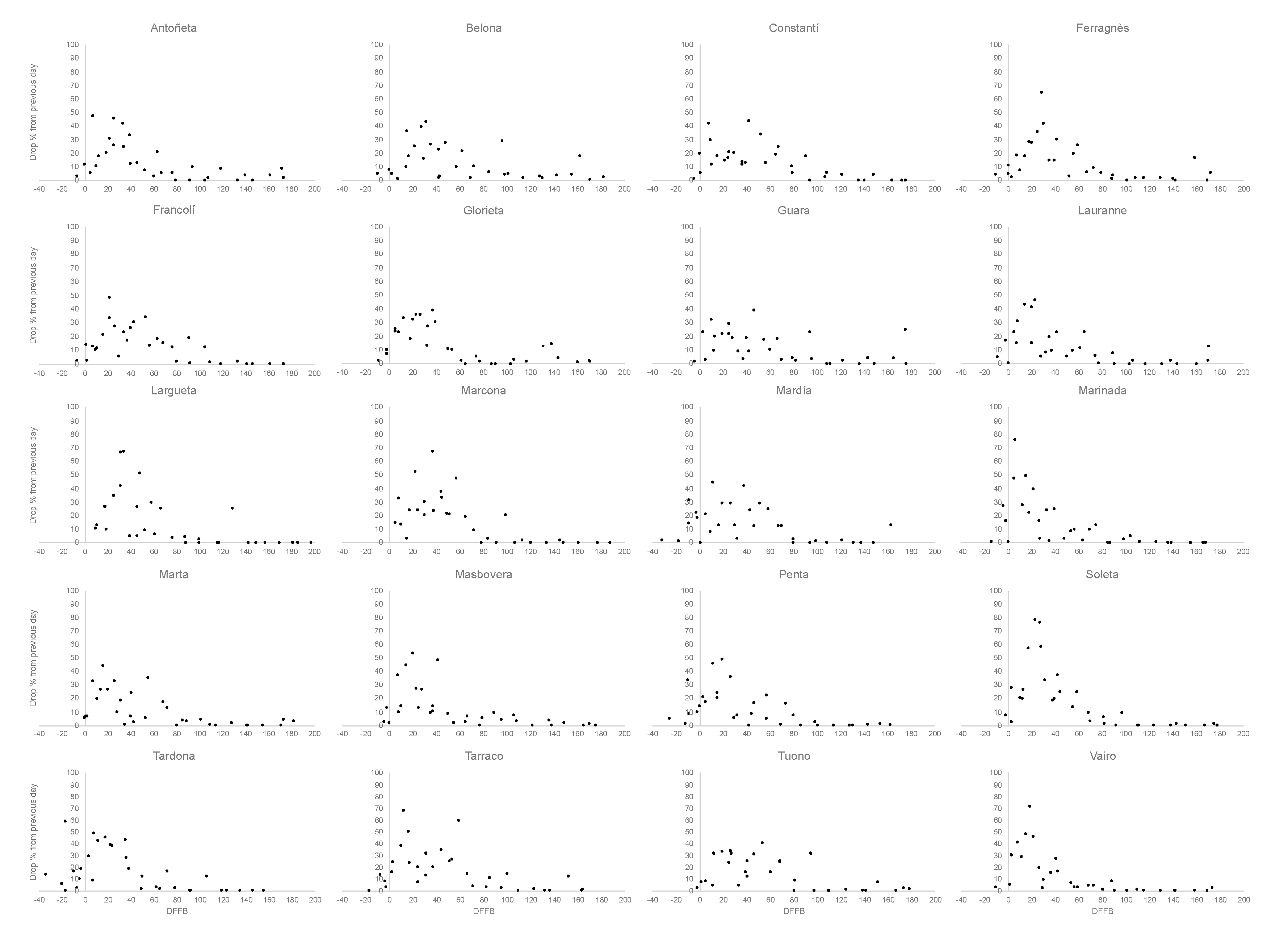
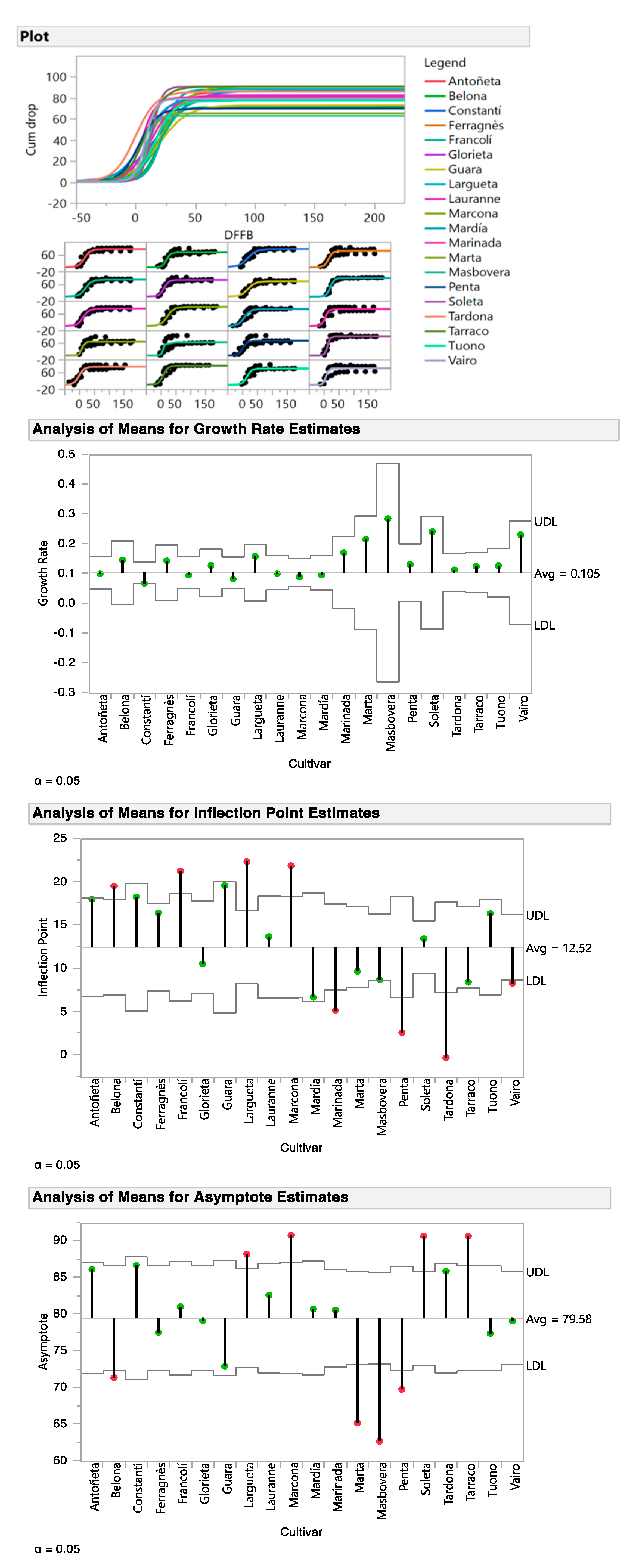

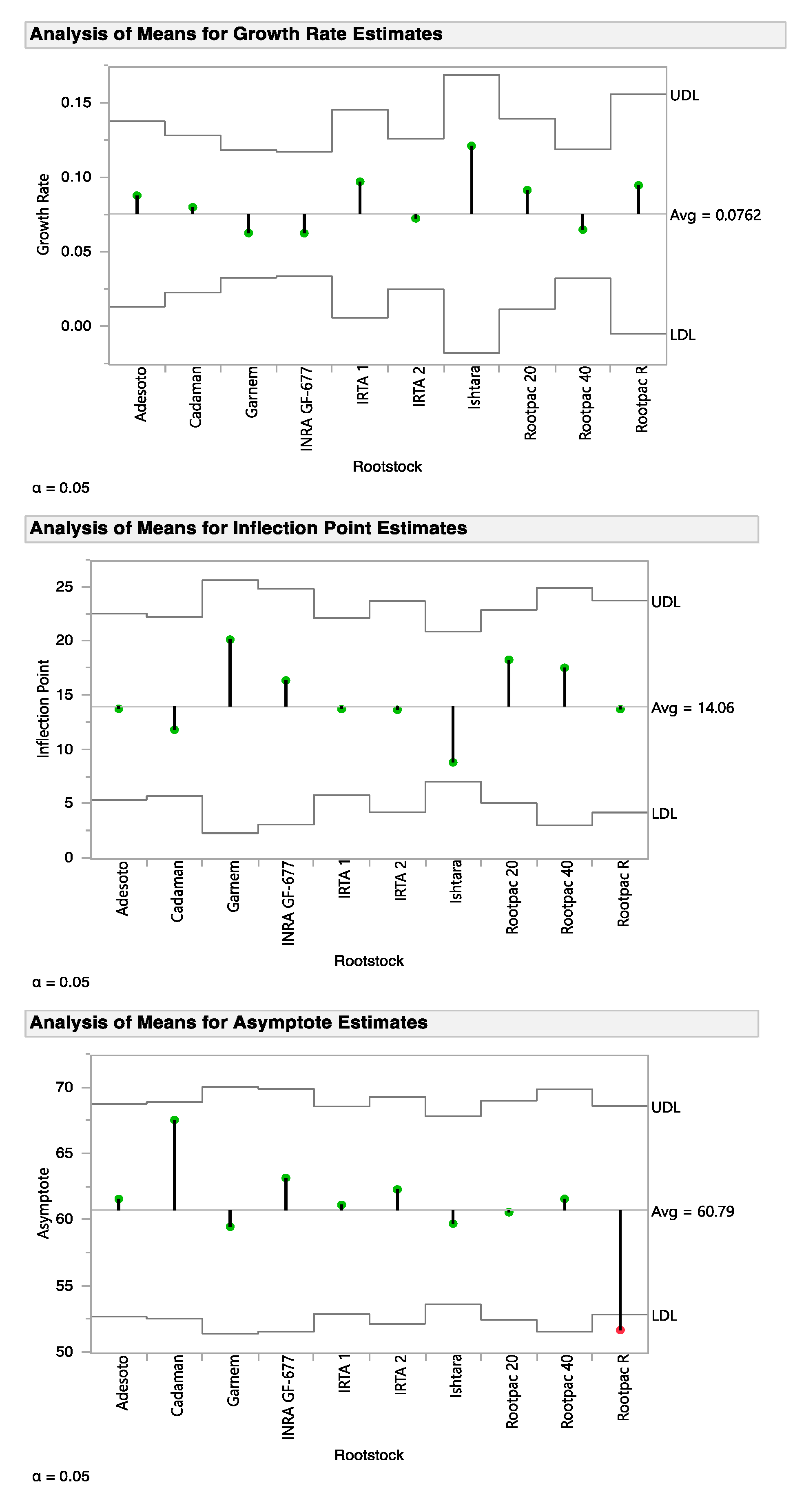
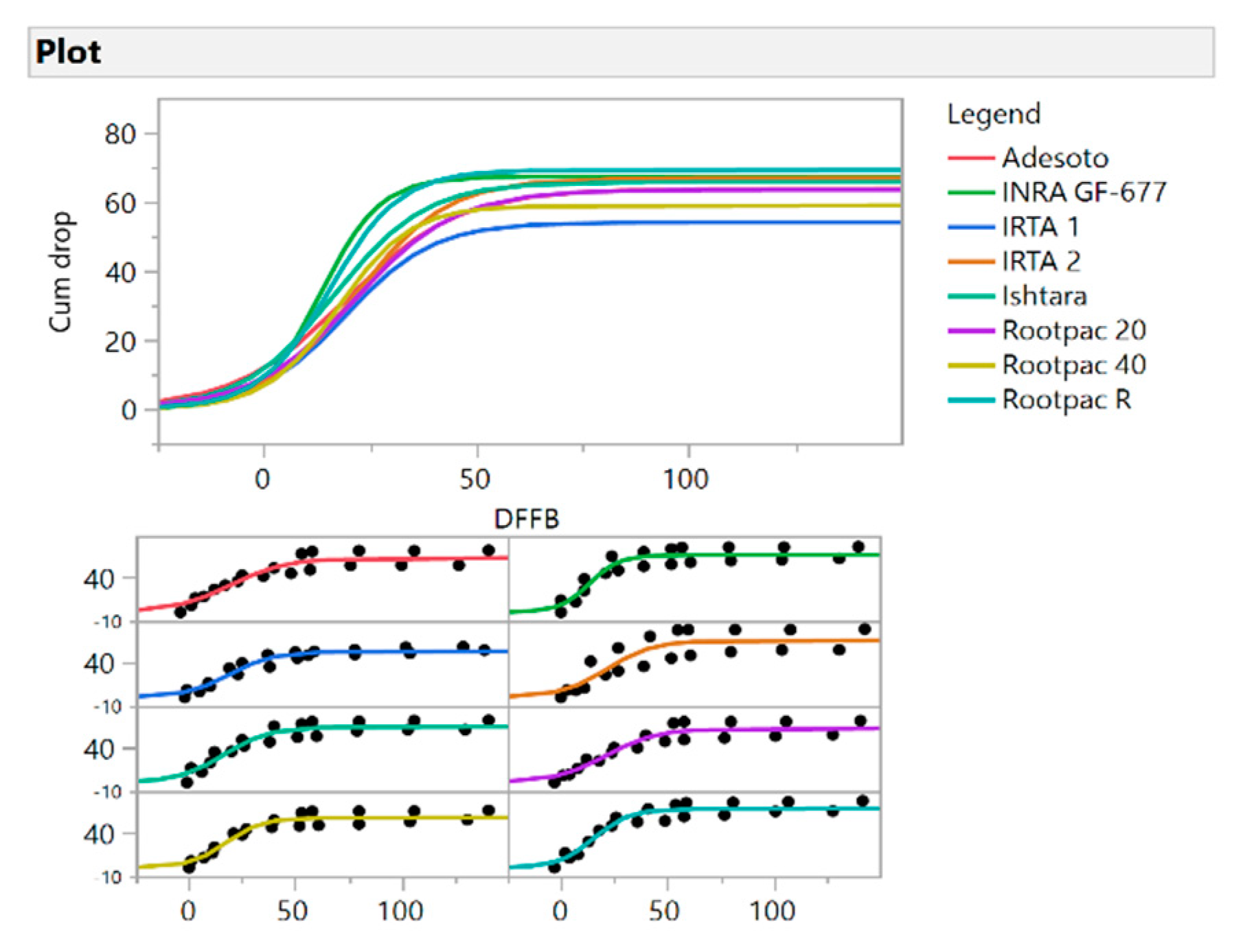


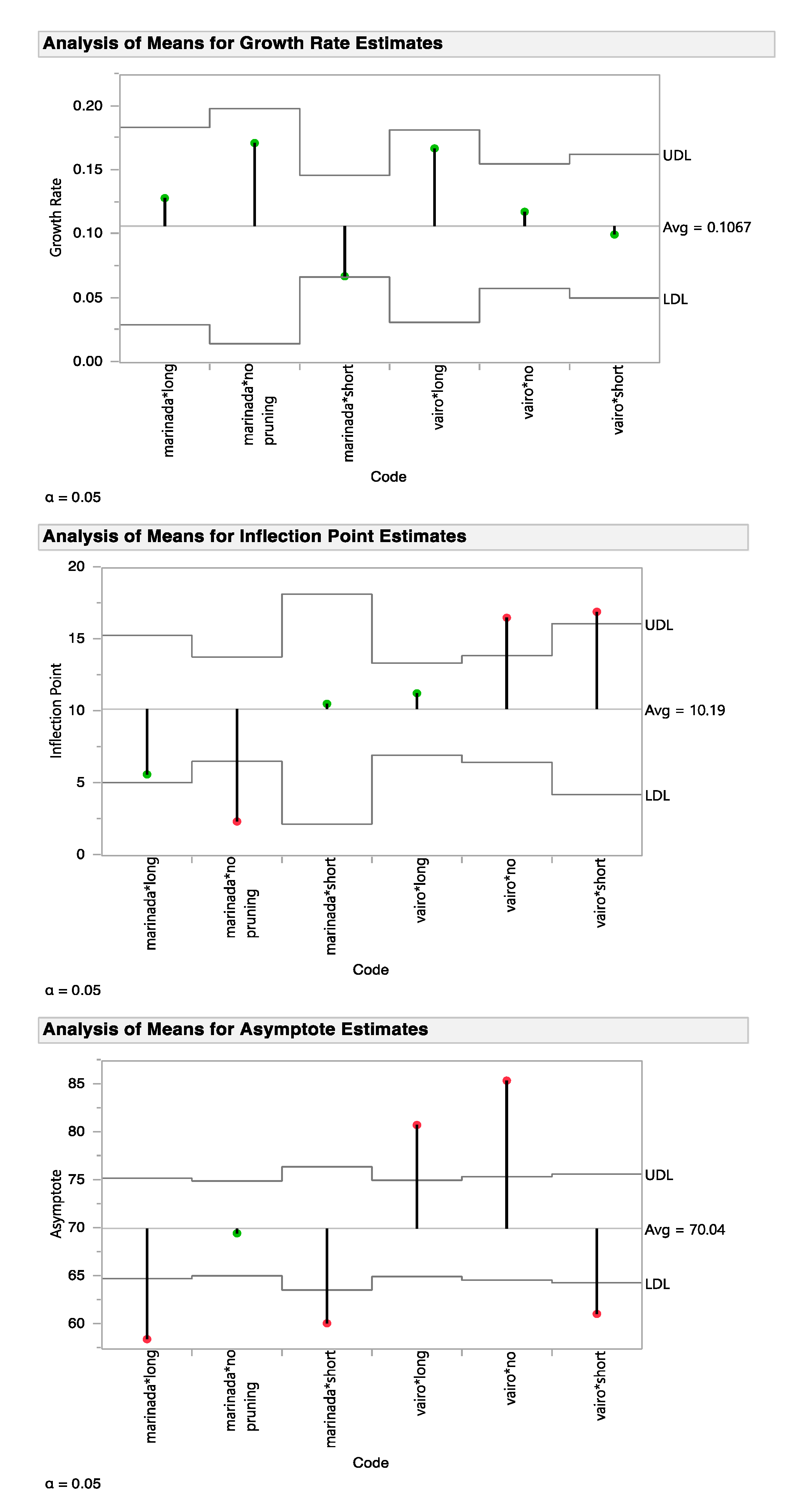


| Plot # | Cultivar | Rootstock | Pruning Type | Number of Buds Sampled | ∑ by Row | |||
|---|---|---|---|---|---|---|---|---|
| 2015 | 2016 | 2017 | 2018 | |||||
| 1 | Antoñeta | INRA GF-677 | 173 | 257 | 178 | 608 | ||
| Belona | 278 | 369 | 235 | 882 | ||||
| Constantí | 226 | 380 | 242 | 848 | ||||
| Ferragnès | 183 | 405 | 257 | 845 | ||||
| Francolí | 225 | 357 | 318 | 900 | ||||
| Glorieta | 259 | 323 | 156 | 738 | ||||
| Guara | 183 | 292 | 229 | 704 | ||||
| Lauranne | 350 | 298 | 326 | 974 | ||||
| Largueta | 236 | 257 | 257 | 750 | ||||
| Marcona | 138 | 153 | 260 | 551 | ||||
| Mardía | 162 | 242 | 218 | 622 | ||||
| Marinada | 191 | 334 | 304 | 829 | ||||
| Marta | 278 | 243 | 267 | 788 | ||||
| Masbovera | 354 | 412 | 163 | 929 | ||||
| Penta | 280 | 247 | 264 | 791 | ||||
| Soleta | 404 | 351 | 437 | 1192 | ||||
| Tardona | 247 | 212 | 390 | 849 | ||||
| Tarraco | 430 | 617 | 543 | 1590 | ||||
| Tuono | 198 | 255 | 184 | 637 | ||||
| Vairo | 300 | 402 | 280 | 982 | ||||
| Total Plot 1 | 5095 | 6406 | 5508 | 17,009 | ||||
| 2 | Marinada | 3376 | 5303 | 8679 | ||||
| Adesoto | 332 | 548 | 880 | |||||
| Cadaman | 410 | 531 | 941 | |||||
| Garnem | 291 | 465 | 756 | |||||
| INRA GF-677 | 302 | 554 | 856 | |||||
| IRTA 1 | 421 | 542 | 963 | |||||
| IRTA 2 | 294 | 522 | 816 | |||||
| Ishtara | 295 | 573 | 868 | |||||
| Rootpac 20 | 318 | 452 | 770 | |||||
| Rootpac 40 | 358 | 569 | 927 | |||||
| Rootpac R | 355 | 547 | 902 | |||||
| Vairo | 2521 | 3628 | 6149 | |||||
| Adesoto | 374 | 495 | 869 | |||||
| INRA GF-677 | 268 | 412 | 680 | |||||
| IRTA 1 | 336 | 408 | 744 | |||||
| IRTA 2 | 280 | 410 | 690 | |||||
| Ishtara | 301 | 554 | 855 | |||||
| Rootpac 20 | 317 | 431 | 748 | |||||
| Rootpac 40 | 345 | 419 | 764 | |||||
| Rootpac R | 300 | 499 | 799 | |||||
| Total Plot 2 | 5897 | 8931 | 14,828 | |||||
| 3 | Marinada | IRTA 2 | 1947 | 2125 | 4072 | |||
| No pruning | 604 | 827 | 1431 | |||||
| Long | 765 | 572 | 1337 | |||||
| Short | 578 | 726 | 1304 | |||||
| Vairo | IRTA 2 | 2086 | 1405 | 3491 | ||||
| No pruning | 633 | 573 | 1206 | |||||
| Long | 774 | 431 | 1205 | |||||
| Short | 679 | 401 | 1080 | |||||
| Total Plot 3 | 4033 | 3530 | 7563 | |||||
Publisher’s Note: MDPI stays neutral with regard to jurisdictional claims in published maps and institutional affiliations. |
© 2021 by the authors. Licensee MDPI, Basel, Switzerland. This article is an open access article distributed under the terms and conditions of the Creative Commons Attribution (CC BY) license (https://creativecommons.org/licenses/by/4.0/).
Share and Cite
Lordan, J.; Zazurca, L.; Rovira, M.; Torguet, L.; Batlle, I.; DeJong, T.; Miarnau, X. Almond Fruit Drop Patterns under Mediterranean Conditions. Agriculture 2021, 11, 544. https://doi.org/10.3390/agriculture11060544
Lordan J, Zazurca L, Rovira M, Torguet L, Batlle I, DeJong T, Miarnau X. Almond Fruit Drop Patterns under Mediterranean Conditions. Agriculture. 2021; 11(6):544. https://doi.org/10.3390/agriculture11060544
Chicago/Turabian StyleLordan, Jaume, Lourdes Zazurca, Mercè Rovira, Laura Torguet, Ignasi Batlle, Theodore DeJong, and Xavier Miarnau. 2021. "Almond Fruit Drop Patterns under Mediterranean Conditions" Agriculture 11, no. 6: 544. https://doi.org/10.3390/agriculture11060544
APA StyleLordan, J., Zazurca, L., Rovira, M., Torguet, L., Batlle, I., DeJong, T., & Miarnau, X. (2021). Almond Fruit Drop Patterns under Mediterranean Conditions. Agriculture, 11(6), 544. https://doi.org/10.3390/agriculture11060544






